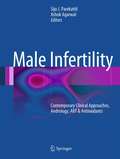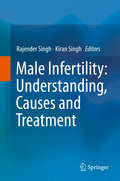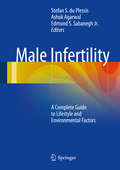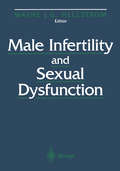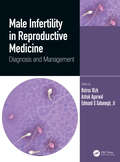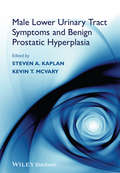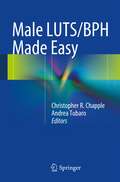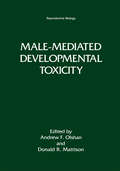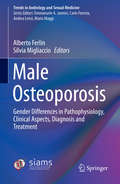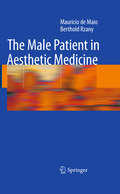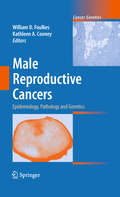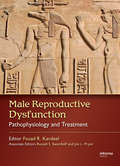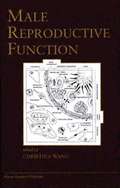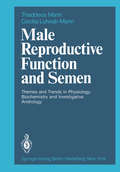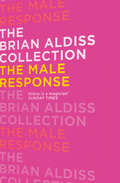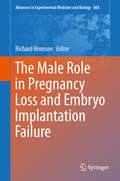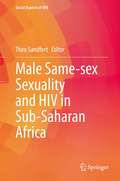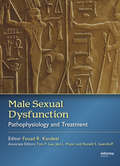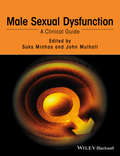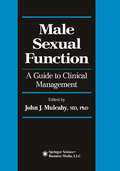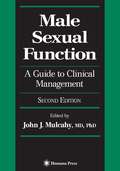- Table View
- List View
Male Infertility: Contemporary Clinical Approaches, Andrology, ART & Antioxidants
by Sijo J. Parekattil and Ashok AgarwalA ground-breaking contribution to the literature, Male Infertility: Contemporary Clinical Approaches, Andrology, ART & Antioxidants offers a comprehensive review of well-established, current diagnostic and treatment techniques for male infertility. This state-of-the-art, evidence-based resource incorporates new multidisciplinary and complementary medicine approaches to create a first-of-its-kind guide to treatment strategies involving antioxidants for male infertility. Designed as an easily accessible practical reference for daily use, Male Infertility: Contemporary Clinical Approaches, Andrology, ART & Antioxidants provides a high quality guide for urologists, reproductive endocrinologists, embryologists, andrologists, biologists and research scientists interested in the role that antioxidants play in male infertility.
Male Infertility: Understanding, Causes and Treatment
by Rajender Singh Kiran SinghThis book covers the latest research on male infertility. The topics discussed range from understanding the genetic basis of infertility, to its causes and treatment. Since infertility is also of great interest to the general public, the book also includes a detailed description of what infertility is and how one can understand the different types. Given the complex etiology of infertility, the book includes a number of chapters defining the known and probable causes of male infertility. Providing detailed information suitable for patients and clinicians alike, it also features a separate section on treatment, the ultimate goal.
Male Infertility: A Complete Guide to Lifestyle and Environmental Factors (Current Clinical Urology Ser.)
by Stefan S. du Plessis Ashok Agarwal Edmund S. Sabanegh Jr.This unique text provides a comprehensive yet concise review of the various environmental factors and lifestyle choices which impact male fertility, with special emphasis on the mechanisms that contribute to decreased sperm production and impaired function. Internationally recognized scientists and clinicians, leaders in the field of infertility, gather their insights and discuss how to prevent, address and cure male infertility caused by factors such as smoking, alcohol consumption, medication and drug use, obesity, dietary and exercise habits, sexually transmitted infections, psychological stress and occupational exposure to chemicals and radiation. Written in an easy to follow, informal yet scientific style, Male Infertility offers invaluable clinical guidelines for physicians and infertility experts and new data and research of great interest to basic scientists, andrologists and embryologists.
Male Infertility and Sexual Dysfunction
by Wayne J. G. HellstromAn analysis of all the current avenues of treatment with emphasis on multidisciplinary considerations. Select international authorities present in-depth coverage of their areas of expertise, each topic covering the background, anatomy, physiology, diagnosis, classification, and treatment. Part I focuses on the study of male infertility and includes discussions of the basic sciences, office evaluation, laboratory and imaging techniques, and the use of testicular biopsy. This is followed by specialised chapters dealing with immunologic infertility, genital inflammation, reactive oxygen species, medical management, sperm processing and preventive adolescent andrology. Part II reflects a more diverse format in the coverage of sexual dysfunction and includes discussions of androgen insufficiency, nocturnal penile tumescence studies, neurotransmission, penile neurology, premature ejaculation, psychogenic impotence and the latest medical, non-invasive and surgical treatments.
Male Infertility in Reproductive Medicine: Diagnosis and Management
by Botros Rizk Ashok Agarwal Edmund S. Sabanegh Jr.This useful illustrated text summarizes for an audience of clinicians in Reproductive Medicine the practical essentials of what they need to know about diagnosis and management of the infertile male patient, whether they need to instruct or liaise with a colleague or undertake the procedures themselves.
Male Infertility in Reproductive Medicine: Diagnosis and Management
by Botros Rizk Ashok Agarwal Edmund S. Sabanegh Jr.This useful illustrated text summarizes for an audience of clinicians in Reproductive Medicine the practical essentials of what they need to know about diagnosis and management of the infertile male patient, whether they need to instruct or liaise with a colleague or undertake the procedures themselves.
Male Lower Urinary Tract Symptoms and Benign Prostatic Hyperplasia
by Steven A. Kaplan Kevin T. McVaryMale Lower Urinary Tract Symptoms and Benign Prostatic Hyperplasia provides urologists of all levels with a practical, highly clinical guide to the variety of different symptoms and problems concerning the male lower urinary tract, including benign prostatic hyperplasia, one of the conditions that urologists most regularly encounter. Evidence-based throughout and written by the world's leading experts in the topic, it comprehensively reviews the very latest in diagnostics and imaging, patient phenotyping, genetic studies, medical and surgical therapies, and lifestyle management in order to help clinicians best manage their patients.Highlights include chapters on: Alpha-Adrenergic Antagonists for Lower Urinary Symptoms Secondary to Benign Prostatic Hyperplasia Phosphodiesterase Type 5 inhibitors for Male LUTS Combination Medical Therapy for Male LUTS Open Simple Prostatectomy Minimally Invasive Therapies Monopolar and Bipolar Transurethral Resection of the Prostate GreenLight Laser Therapy Containing pitfall boxes and key points throughout to aid quick and easy understanding of the key information, this excellent book is an essential read for the modern-day urologist.
Male Lower Urinary Tract Symptoms and Benign Prostatic Hyperplasia
by Steven A. Kaplan Kevin T. McVaryMale Lower Urinary Tract Symptoms and Benign Prostatic Hyperplasia provides urologists of all levels with a practical, highly clinical guide to the variety of different symptoms and problems concerning the male lower urinary tract, including benign prostatic hyperplasia, one of the conditions that urologists most regularly encounter. Evidence-based throughout and written by the world's leading experts in the topic, it comprehensively reviews the very latest in diagnostics and imaging, patient phenotyping, genetic studies, medical and surgical therapies, and lifestyle management in order to help clinicians best manage their patients.Highlights include chapters on: Alpha-Adrenergic Antagonists for Lower Urinary Symptoms Secondary to Benign Prostatic Hyperplasia Phosphodiesterase Type 5 inhibitors for Male LUTS Combination Medical Therapy for Male LUTS Open Simple Prostatectomy Minimally Invasive Therapies Monopolar and Bipolar Transurethral Resection of the Prostate GreenLight Laser Therapy Containing pitfall boxes and key points throughout to aid quick and easy understanding of the key information, this excellent book is an essential read for the modern-day urologist.
Male LUTS/BPH Made Easy
by Christopher R. Chapple Andrea Tubaro Benign prostatic enlargement (BPE) is one of the most common diseases in older men and it is caused by an histopathological condition called “benign prostatic hyperplasia (BPH). Clinical manifestations of BPH include symptoms, signs and sequelae of bladder outlet obstruction caused by the enlarged prostate. Although no longer life-threatening, the prevalence of moderate-to-severe urinary symptoms in the community is high, increasing from 22% among men aging 50-59 years to 45% among those in the seventh decade of life. Male LUTS/BPH Made Easy is a full-color comprehensive reference on the management of lower urinary tract symptoms (LUTS) due to Benign Prostatic Enlargement (BPE). Aimed at urologists in residence and training, Male LUTS/BPH Made Easy, updates the reader on the most current treatments and assists in clinical decision making based on the latest evidence.
Male-Mediated Developmental Toxicity (Reproductive Biology)
by Andrew F. OlshanThe cause of many of the adverse reproductive outcomes and developmental diseases among offspring is not well understood. Most of the epidemiologic and experimental animal research has focused on the relationship between maternal exposures including medications, tobacco smoke, alcohol, infections, and occupation and the occurrence of spontaneous abortion, low birth weight, and birth defects. The potential role of paternal exposures has not been investigated as extensively despite long-standing animal research that demonstrates the induction of mutations in the male germ cell after exposure to certain agents and subsequent reproductive failure or early pregnancy loss. Given this relative lack of interest, acquisition of epidemiologic data and the development of a definitive model or mechanism for potential male-mediated effects has been hindered. However, recent laboratory and epidemiologic investigations have suggested that paternal exposures may be more important than previously suspected. This topic has been termed by some as "male-mediated developmental toxicity. " This is meant to refer to the effects of exposures and other factors relating to the male parent that result in toxicity to the conceptus and abnormal development. The developmental endpoints of interest can include fetal loss, congenital abnormalities, growth retardation, cancer, and neurobehavioral effects. These effects may operate through a variety of mechanisms including gene mutation, chromosomal aberrations, seminal fluid transfer of toxicants and epigenetic events.
Male Osteoporosis: Gender Differences in Pathophysiology, Clinical Aspects, Diagnosis and Treatment (Trends in Andrology and Sexual Medicine)
by Alberto Ferlin Silvia MigliaccioThis book represents a comprehensive, clinically oriented text covering all aspects of male osteoporosis, from the basic concepts of bone physiology and regulation of bone remodeling in men, the causes and pathophysiological mechanisms responsible for the most frequent causes of osteoporosis, to diagnostic and screening protocols, as well as prevention and treatment approaches. It offers a broad overview of male osteoporosis by specialists involved in research and clinical practice and discusses the practical issues encountered. Filling a gap in the literature, this volume is a valuable resource for general practitioners, clinical endocrinologists, geriatricians and experts in osteoporosis.
The Male Patient in Aesthetic Medicine
by Mauricio de Maio Berthold Rzanyare g rowing among core specialists in the aesthetic field, aesthetic medicine is advancing exponentially. The two authors of this text have worked together to provide a knowled- able and practical approach to the male patient in aesthetic medicine. April 2009 Timothy Corcoran Flynn, M.D. Clinical Professor, University of North Carolina at Chapel Hill Medical Director, Cary Skin Center, Cary, NC 27608, USA Preface Men are different from women in many ways. Male aesthetics are different from female aesthetics. Most readers would agree with this statement. However, as the majority of our patients are still female, even cosmetic physicians may tend to treat their male patients like female patients. This can lead to dissatisfaction of the patient and consequently of the cosmetic physician. As the demand for aesthetic procedures in male patients is rising, there is a need for good textbooks on this subject. The aim of this book is to explain the specifities of the ageing process and facial aesthetics in men and to present the treatments available. In addition, common skin conditions and diseases that also influence the male aesthetic appearance will be discussed. The book written from the perspectives of a plastic surgeon and a dermatologist should enable us to treat our male patients better, and by that increase the satisfaction of our patients and, last not least, our satisfaction as the treating physicians.
Male Reproductive Cancers: Epidemiology, Pathology and Genetics (Cancer Genetics)
by William D. Foulkes Kathleen A. CooneyKnowledge about cancer genetics is rapidly expanding, and has implications for all aspects of cancer research and treatment, including molecular causation, diagnosis, prevention, screening, and treatment. Additionally, while cancer genetics has traditionally focused on mutational events that have their primary effect within the cancer cell, recently the focus has widened, with evidence of the importance of epigenetic events and of cellular interactions in cancer development. The role of common genetic variation in determining the range of individual susceptibility within the population is increasingly recognized, and is now being widely addressed using information from the Human Genome Project. These new research directions will highlight determinants of cancer that lie outside the cancer cell, suggest new targets for intervention, and inform the design of strategies for prevention in groups at increased risk. Today, the NCI is putting more and more money into research into the genetics of cancer. The very first of the NCI’s stated research priorities is a project called The Cancer Genome Atlas. The Cancer Genome Atlas (TCGA) is a comprehensive and coordinated effort to accelerate the understanding of the molecular basis of cancer through the application of genome analysis technologies, including large-scale genome sequencing. The NCI and the NHGRI (National Human Genome Research Institute, where the series editor is employed) have each committed $50 million over three years to the TCGA Pilot Project. This book proposes cover the latest findings in the genetics of male reproductive cancers; specifically cancers of the prostate and testes. The volume will cover the epidemiology of these cancers; model systems, pathology, molecular genetics, and inherited susceptibility.
Male Reproductive Dysfunction: Pathophysiology and Treatment
by Fouad R. KandeelThe successful practice of reproductive medicine requires the coordinated efforts of many medical professionals. Male Reproductive Dysfunction: Pathophysiology and Treatment describes the most significant advances towards the improved overall understanding of male reproductive dysfunction and provides practical strategies for the assessment and man
Male Reproductive Function (Endocrine Updates #5)
by Christina WangMale Reproductive Function gives an up-to-date review on the physiology and disease processes associated with the male reproductive system. The first few chapters describe the regulation of the functions of the testis and the integration of its components: germ cells, Sertoli cells and Leydig cells. This is followed by a description of puberty and aging, and the disorders or dysfunction that may be associated with these physiological processes. Discussions on the current methods for the diagnosis and treatment of male hypogonadism, male infertility and male sexual dysfunction follow, with detailed descriptions of types of androgen replacement and the benefits and risks of such treatment. The book concludes with the development of male contraception and the possible influence of the environment on the male reproductive system. Male Reproductive Function represents a conglomeration of the efforts of experts in andrology from all over the world, both in basic cellular/molecular biology as well as in clinical science and practice. This book is suitable for endocrinologists, urologists, general internists, gynecologists and other students in the field of male reproduction.
Male Reproductive Function and Semen: Themes and Trends in Physiology, Biochemistry and Investigative Andrology
by T. Mann C. Lutwak-MannTo present a coherent and meaningful survey of scientific research endeavour in an area that has expanded as fast as physiology and biochemistry of reproduction in the male is no mean task these days. No less prodigious than the growth of knowledge of male reproductive function has been the rate at which the outpouring of publications on this subject has continued since the appearance of 'The Biochemistry of Semen and of the Male Reproductive Tract' in 1964. Since cyclopaedic treatment of this vast literature did not appeal to us, we have made no attempt either to rehash the material contained in that book or to enlarge the bibliography beyond the nearly 3500 references included in the present treatise. At the same time, whilst writing, we felt strongly that to advance, it is necessary to understand the past, and for this reason we have not hesitated to refer (especially in the introductory chapter) to a number of those fundamental early discoveries in which today's knowledge is deeply and firmly rooted.
Male Reproductive Organs (tactile)
by RnibA diagram showing the male reproductive organs. Textures have been used to differentiate sections, and labels indicate various parts.
The Male Response (The Brian Aldiss Collection)
by Brian AldissWritten at the peak of the swinging sixties, this is an ironic, hilarious and frank investigation of sexual politics and the male sex drive. The Brian Aldiss collection includes over 50 books and spans the author’s entire career, from his debut in 1955 to his more recent work.
The Male Role in Pregnancy Loss and Embryo Implantation Failure (Advances in Experimental Medicine and Biology #868)
by Richard BronsonNovel topics compiled in this one-of-a-kind volume provide tantalizing hints for clinical application through future translational research. Only recently have we come to ask what role the male might play in pregnancy loss and embryo implantation failure, beyond contributing an abnormal set of paternal chromosomes at fertilization. This volume explores the recent evidence that these conditions might also be related to the transmission of previously unrecognized chromosomal micro-deletions and duplications, or via the epigenetic dysregulation of early embryonic gene function by spermatozoal microRNAs or alterations in sperm DNA methylation patterning, or by DNA damage secondary to either reactive oxygen species or environmental toxicants. In addition, the composition of seminal plasma has been found to be highly complex, containing many factors that play important roles in altering the uterine environment and the female immune system permissive of embryo implantation and trophectoderm outgrowth leading to successful pregnancy. Coverage includes an examination of both spermatozoa and seminal fluid component factors.
Male Same-sex Sexuality and HIV in Sub-Saharan Africa (Social Aspects of HIV #7)
by Theo SandfortThis book addresses the impact of HIV on populations of men who have sex with men in Africa and local responses to the issue. It documents the enduring existence of a rich variety of same-sex practices between men. More critically, it analyses how the denial and social rejection of same-sex sexuality, together with the legacy of criminalization by former colonial rulers, has not only fueled the transmission of HIV between men, but has also impeded an effective response. The book also documents some of the outstanding progress that has been made and acknowledges the differences between African countries. Through its focus on lived realities and grassroots activism in Africa, this book will appeal to researchers, policy makers and practitioners alike.
Male Sexual Dysfunction: Pathophysiology and Treatment
by Fouad R. KandeelAlthough impotence may be the most widely recognized manifestation of male sexual dysfunction, many other forms of sexual disorders do not involve the erectile mechanism, from deficiencies of desire to disturbances in ejaculatory function to the failure of detumescence. With such a myriad-and often co-existing-number of disorders, the successful tr
Male Sexual Dysfunction: A Clinical Guide
by Suks Minhas John MulhallSexual dysfunction affects men of all ages and incidence rates are expected to double by 2025 resulting in a major health burden. Though normal sexual function is an important aspect of health and well-being, sadly, this common condition still carries an associated stigma. As a result, affected men are often reluctant to approach their doctor and, instead, may live for many years with sexual dysfunction, often to the detriment of their personal lives. Male Sexual Dysfunction: A Clinical Guide covers all the common problems encountered by the clinician in this rapidly expanding and developing field. With full color throughout, this easy to read guide provides a comprehensive and systematic approach to patient management. Packed with key features, every chapter will contain flow diagrams and algorithms, key points, clinical pearls, "what to avoid" boxes, and numerous tables, graphs and photographs . This book provides: Comprehensive focus on the core clinical areas of physiology/pharmacology, investigation, diagnosis, management and surgical options Coverage of all treatment pathways, including psychological, pharmacologic and surgical A straightforward, logical approach to clinical management An experienced and international editor and contributor team Expertly-written, this book is the perfect resource for urologists and general practitioners with an interest in this highly topical area, as well as those about to undergo their urology trainee examinations.
Male Sexual Dysfunction: A Clinical Guide
by Suks Minhas John MulhallSexual dysfunction affects men of all ages and incidence rates are expected to double by 2025 resulting in a major health burden. Though normal sexual function is an important aspect of health and well-being, sadly, this common condition still carries an associated stigma. As a result, affected men are often reluctant to approach their doctor and, instead, may live for many years with sexual dysfunction, often to the detriment of their personal lives. Male Sexual Dysfunction: A Clinical Guide covers all the common problems encountered by the clinician in this rapidly expanding and developing field. With full color throughout, this easy to read guide provides a comprehensive and systematic approach to patient management. Packed with key features, every chapter will contain flow diagrams and algorithms, key points, clinical pearls, "what to avoid" boxes, and numerous tables, graphs and photographs . This book provides: Comprehensive focus on the core clinical areas of physiology/pharmacology, investigation, diagnosis, management and surgical options Coverage of all treatment pathways, including psychological, pharmacologic and surgical A straightforward, logical approach to clinical management An experienced and international editor and contributor team Expertly-written, this book is the perfect resource for urologists and general practitioners with an interest in this highly topical area, as well as those about to undergo their urology trainee examinations.
Male Sexual Function: A Guide to Clinical Management (Current Clinical Urology)
by John J. MulcahyLeading clinicians and basic scientists comprehensively survey for the general practitioner the background, diagnostic tools, associated conditions, causes, and treatments of erectile dysfunction. Here the busy practitioner will find concise and useful information on the anatomy and physiology of erectile function and dysfunction, ejaculatory disorders, Peyronie's disease, and priapism-as well as a chapter on female sexual dysfunction-in addition to thorough chapters on diagnosis and treatment.
Male Sexual Function: A Guide to Clinical Management (Current Clinical Urology)
by John J. MulcahyThe first edition of Male Sexual Function: A Guide to Clinical Management was published in 2001. Since that time, two new oral medications for erectile dysfunction ® ® (ED), Vardenafil (Levitra ) and Tadalafil (Cialis ), have been introduced. Links between ED and lower urinary tract symptoms have been postulated, advances in the basic science of erectile physiology have occurred, and the appreciation of ED as a form of endothelial dysfunction and a harbinger of other more potentially lethal forms of vascular disease has become more widespread. In some instances, third-party payers have reduced or eliminated coverage for ED treatments in an attempt to cut costs. They have classified sexual activity as “recreational,” “lifestyle,” or not medically necessary, but have failed to appreciate the negative consequences of ED, such as depression with all of its ramifications. Male Sexual Function: A Guide to Clinical Management, Second Edition is a comp- hensive overview of the field of male sexual function and includes a chapter on female sexual dysfunction, an emerging field with a very high incidence in the population and an ever-growing following.
